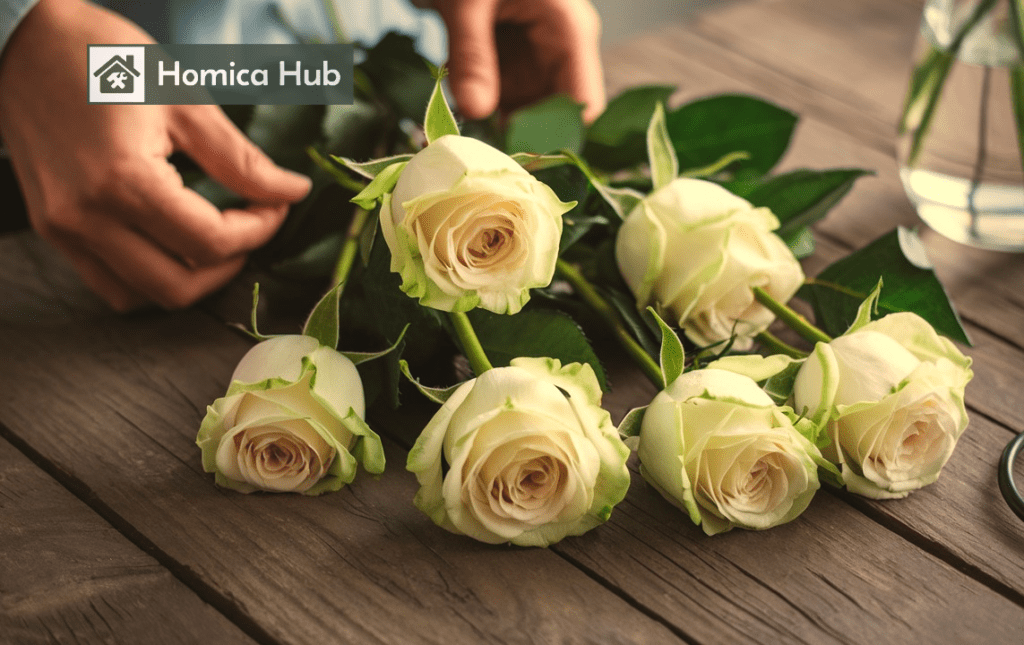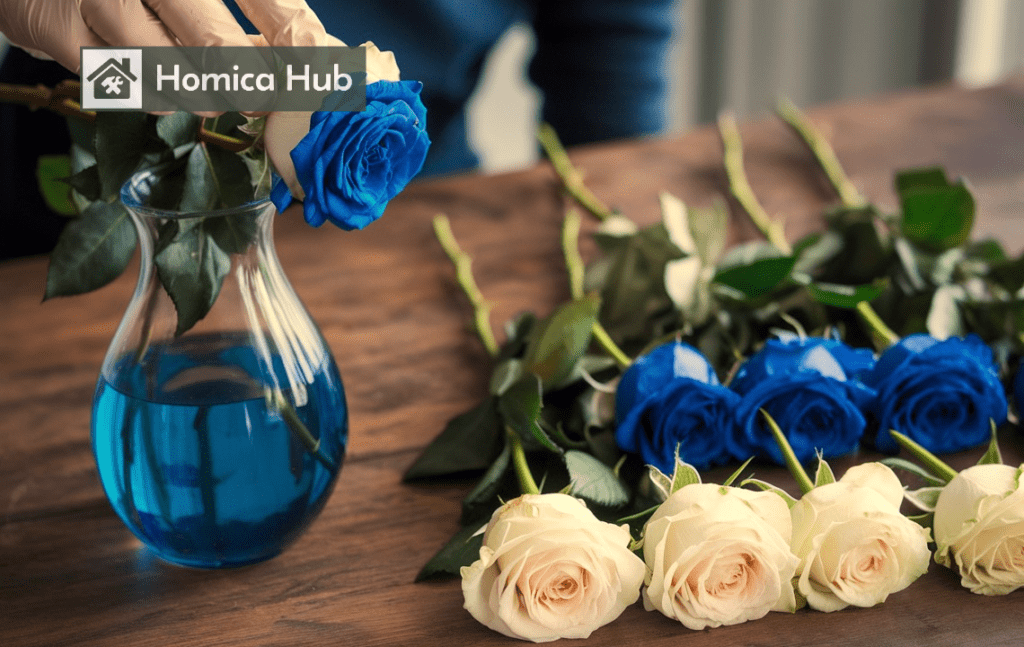Blue roses have a magical charm that has fascinated people for centuries. They are often seen as a symbol of mystery, rarity, and beauty. Nature doesn’t produce them, you can create these striking flowers at home with simple techniques. The process of creating blue roses involves dyeing fresh white roses to achieve the desired color. We’ve outlined three effective methods to help you craft stunning blue roses: Absorption method, Dip-dyeing method, and the Spray method.
Table of Contents
The Absorption Method
The absorption method is one of the best ways to create blue roses at home. It works by letting the flower absorb the dye through its stem, gradually changing the color of the petals. This method is easy to follow and gives reliable, vibrant results. In this guide, we provide a detailed step-by-step process to help you successfully create stunning blue roses.
Things You Will Need
1) Fresh white roses
2) Blue food coloring or floral dye.
3) A clean glass vase.
4) Room temperature water.
5) Sharp scissors or a knife.
6) Gloves (optional, to avoid dye stains).
1: Select Fresh and Healthy Roses

The first step to making blue roses is selecting the right flowers. Fresh, healthy white roses are the best choice because they absorb the dye more effectively. Look for roses with firm petals and no signs of wilting or discoloration. If the roses are too old or damaged, they may not absorb the blue color as evenly. Choosing high-quality flowers ensures vibrant, beautiful results, so take your time to pick the freshest blooms you can find.
2: Prepare the Water and Dye for Roses

Prepare the dye solution for your blue roses. Start by filling a vase halfway with room temperature water. Then, add a few drops of blue food coloring into the water . Mix it well to ensure the dye is evenly distributed. The amount of dye you add will determine how deep or light the blue color will be. If you want a darker shade, add more drops, and for a lighter shade, use fewer drops.
3: Cut the Roses Stems

Prepare the rose stems to help them absorb the dye better. Use sharp scissors or a knife to cut the bottom of each stem at a 45-degree angle. This angled cut allows the stems to absorb water more efficiently. You can also make a few small vertical slits at the base of the stems to help the flowers take in the dye faster. This increases the surface area, making it easier for the dye to travel up the stem and into the petals. Properly trimming the stems is crucial for the roses to absorb the blue color evenly.
4: Put Roses in the Vase

Place the rose stems into the prepared dye solution. Take the freshly cut stems and gently put them into the vase filled with blue water. Make sure the stems are submerged deep enough to allow the flowers to absorb the dye effectively. The longer the stems are in the water, the more dye they will absorb, which will turn the petals blue. Place the vase in a cool, shaded area, away from direct sunlight, to help the roses take in the dye slowly and evenly.
5: Wait and Watch The Progress

Now, all you need to do is be patient. The roses will change color as they absorb the dye from the water. This process can take 4 to 6 hours, but it may take longer for the petals to fully turn blue, depending on how deep you want the color. Check the roses every few hours to see the progress and make sure the stems are still submerged in the dye. If the water level drops, add more colored water to ensure the roses continue absorbing the dye. The longer you leave them, the more vibrant the blue color will become.
6: Remove Roses from dye solution

Once your roses have reached the desired shade of blue, carefully take the roses out of the vase and rinse the stems under clean water to remove any excess dye. This helps prevent the dye from staining anything else. After rinsing, you can place the roses back in a fresh vase with clean water to keep them hydrated.
Dip-Dyeing Method

The dip-dyeing method is faster and more direct way to create blue roses. Rather than waiting for the stems to absorb the dye, you dip the petals into the dye solution, allowing them to quickly take on a beautiful blue color. This method gives you more control over how dark or light the blue will be, making it easy to achieve the exact look you want. It’s an excellent choice if you need quicker results without sacrificing the quality of your roses.
Things You Will Need
1) Blue food coloring
2) Water
3) A shallow container or bowl
4) White roses
5) Scissors (optional)
Steps to Follow
1) Take a shallow container or bowl, mix a few drops of blue food coloring with water. Stir the solution well to make sure the dye is evenly spread in the water. The depth of the water should be enough to submerge the rose petals but not the stem.
2) Take a white rose and hold it by the stem. Gently dip the petals into the blue dye solution. You can dip only the tips of the petals for a soft blue effect, or dip the whole flower for a stronger, uniform color.
3) Allow the petals to absorb the dye. The blue color will quickly spread across the petals, starting from the areas that were dipped. You can leave the petals in the dye for a few seconds or longer, depending on how deep you want the color to be.
4) Once the petals have absorbed enough dye, carefully remove the rose from the solution. Let the rose sit for a few minutes to allow the dye to set and dry.
If you want a more dramatic look, you can dip the petals multiple times, each time for a longer period, to deepen the blue color. You can also experiment with different shades of blue by adjusting the amount of food coloring in the water.
5) After the rose has dried, you can trim the stem if needed and place it in a vase with clean water. Your beautiful blue rose is now ready to be displayed!
The Spray Method

The spray method is another simple and effective method to create blue roses. This is the most fastest way to create blue roses. It involves spraying the dye directly on the petals. This method is perfect if you want a more artistic touch or achieve a subtle color effect on the flowers. It also allows you to color the entire rose or focus on specific areas, such as the edges of the petals.
Things You Will Need
1) Blue food color
2) Water
3) A spray bottle
4) White roses
5) Hand Gloves
6) Scissors (optional)
Steps to Follow
1) Mix a few drops of blue food color with water in a spray bottle to prepare your dye solution.
2) Shake the bottle well to ensure the dye is evenly mixed with the water.
3) Put on gloves, hold the white rose by its stem, and gently spray the petals with the blue dye solution. You can spray the entire flower or focus on the tips of the petals for a gradient effect.
4) Spray lightly and evenly to avoid over-saturating the petals with color.
5) Allow the dye to dry while you move on to the next flower, or let the sprayed rose sit for a few minutes.
6) For a deeper shade of blue, respray the petals after they’ve dried, allowing the color to build up.
7) Experiment with different spray techniques, such as spraying from various angles, to create unique patterns on the petals.
Related Post
3 Easy Ways To Create Blue Roses
How to Keep Fresh Flowers Alive in Vase
FAQs
1) Which method creates the deepest blue roses?
The absorption method typically results in deeper and more even blue hues.
2) Can I make blue roses without food coloring?
While food coloring is the most common and easiest method, you can also try using natural dyes such as blue dye from certain fruits or vegetables. However, food coloring is more reliable and produces a brighter blue.
3) Can I dye roses with other liquids besides water?
While water is the most common liquid for dyeing roses, you can also experiment with other liquids like flavored water or even vinegar-based solutions. However, these may alter the way the roses absorb the dye and change their appearance.
4) Is it possible to create a darker or lighter shade of blue?
Yes, you can control the shade of blue by adjusting the amount of food coloring you add to the water. For a darker shade, add more dye, and for a lighter shade, reduce the number of drops.
5) Which is the most fastest way to creates blue roses?
The Spray method is the most fastest way to create blue roses.



